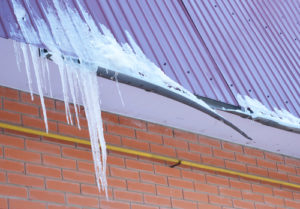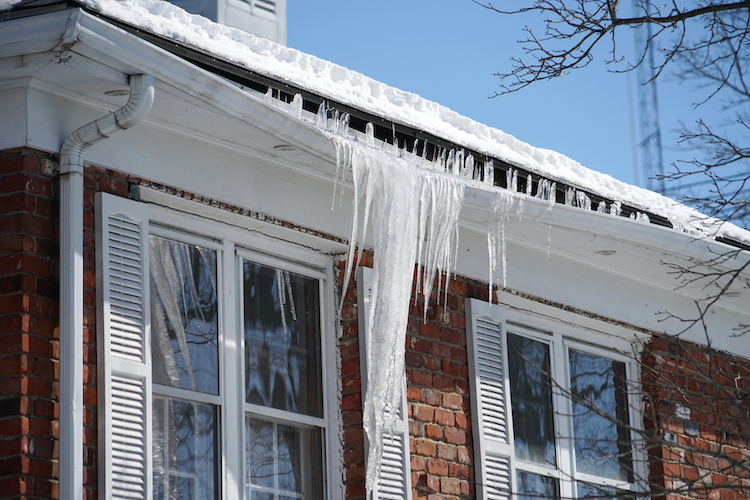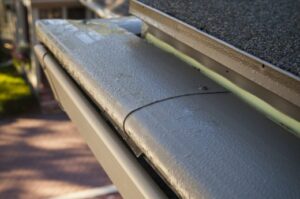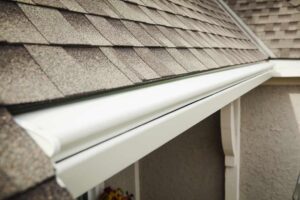Winter Has Its Gutter Challenges
In the colder months, it’s not only harder to clean and maintain gutter systems but also more dangerous. Chipping ice dams from roofs might cause eye and face damage. Ladder rungs can ice up and lead to serious falls. Same for cleaning your roof of snow after a recent storm.
Furthermore, there’s no stopping snow accumulation in your gutters if storms come one after another. In those situations, the weight increase and development of blockages could bring a gutter system down. In turn, damage will be inflicted on your roof, siding, soffit, and fascia.
Will Snow Damage Gutters?
One of the most challenging aspects of winter is the accumulation of heavy snow on roofs and gutter systems. Snow and ice can cause significant damage to gutters, particularly if the gutters are not of high quality or if the roof is aged or structurally weakened.
Snow can harm gutters in two primary ways.
Ice Dams
Ice dams occur when snow accumulates on the roof. This snow then melts, and the resulting water flows off the roof, only to freeze again when it reaches the colder edges and gutters of your home.
You might wonder why the snow melts and then refreezes, forming ice dams. The issue often lies in heat escaping from the attic, which warms the roof and causes the underside of the snow to melt. This process leads to snowmelt refreezing in the gutters, creating substantial ice dams.
The formation of ice dams results in blocked gutters. Consequently, melted snow cannot drain effectively from the roof, leading to prolonged moisture exposure. This excessive moisture can penetrate beneath tar paper, shingles, and even the plywood of the roof, jeopardizing the integrity of the soffit, fascia, and the overall structure of the roof.
Ice Buildup
When ice accumulates, it hinders the snow on your roof from melting and flowing properly through the gutter system. This situation causes the runoff to spill over the gutter’s edge, resulting in the formation of large icicles. These icicles pose a dual threat: they add excessive weight to your gutters, potentially damaging them, and they can be hazardous if they fall, posing a risk to your family and any objects below, like your deck.
Keeping Your Gutters from Being Damaged by Snow
All is not lost. There are ways to keep your gutters safe from snow damage during the height of winter. Here are four actions to take to get your system ready for the colder months.
-
Prepare The Gutters Ahead of Time

The Boy Scouts aren’t wrong when they ask their members to “Be Prepared.” Caring for your gutter system well ahead of the first snow helps you avoid serious problems later. Thus, you want to ensure the hangers that secure the gutters and downspouts are tight, the guards are firmly attached, and there are no debris in the channels.
Clearing the units of collected gunk is imperative. Even the smallest amount can mix with snow and freeze into an ice dam. When this takes place, fresh water backs up and starts splashing around the roof’s shingles. The result could be water damage to your internal walls and ceilings.
-
Strengthen the Gutter Supports
Kansas Citians are used to heavy snowfall, therefore every effort on behalf of homeowner’s should be made to strengthen the existing structure. Extra hangers and heavier bolts will help in these situations. Another consideration is matching sizes to the amount of precipitation. Year after year, winter snowfall fluctuates. In 2018, we had a lot of snow! In order to adequately prepare for the fluctuations, gutters and downspouts need to be properly sized. Otherwise, you may be faced with structural gutter problems.
-
Add a Warming Cable
Adding a warming cable to the edge of the roof or the gutter guard controls the temperature and minimizes the risk of over-accumulation. When properly heated, the warming cable converts the snow back to its original form, thus allowing it to flow quickly into the gutters and downspouts. Even if the temperature is well below freezing, the water will be warm enough to reach its destination before icing over.
-
Check the roof
While this may sound incorrect, a well-insulated roof free of escaping air is important. Pockets of warmer air loosen snow. As it flows down to the gutters it will pick up additional snow. Eventually, all of it ends up in the gutters as one big clump, and without proper strength, there’s every chance the system will collapse.
When the temperature is evenly distributed across the roof’s surface, then the melt is slowed and better handled by the gutters. In addition, it prevents patches to freeze in or around the system.
The best way to determine if your gutter system is winter ready is to contact the experts at K-Guard. Call 913-229-7550 to book a free estimate on your current setup and learn what our leaf free gutter system can do to prevent maintenance and home improvement expense due to failed gutters.




